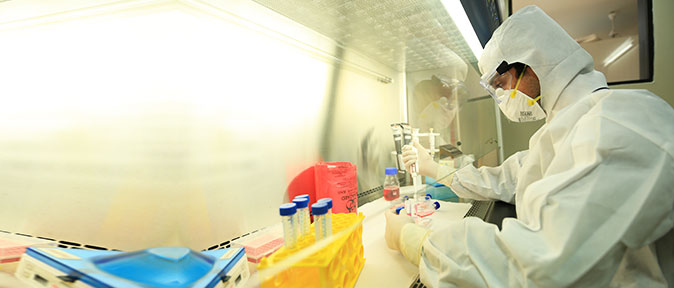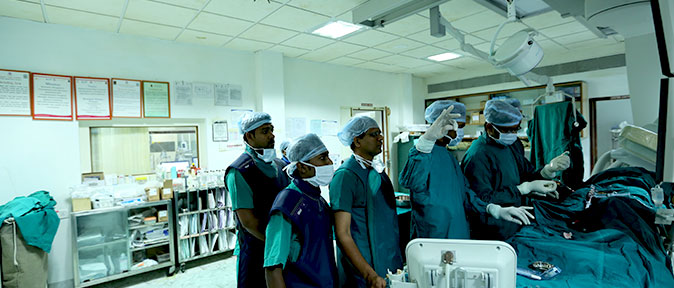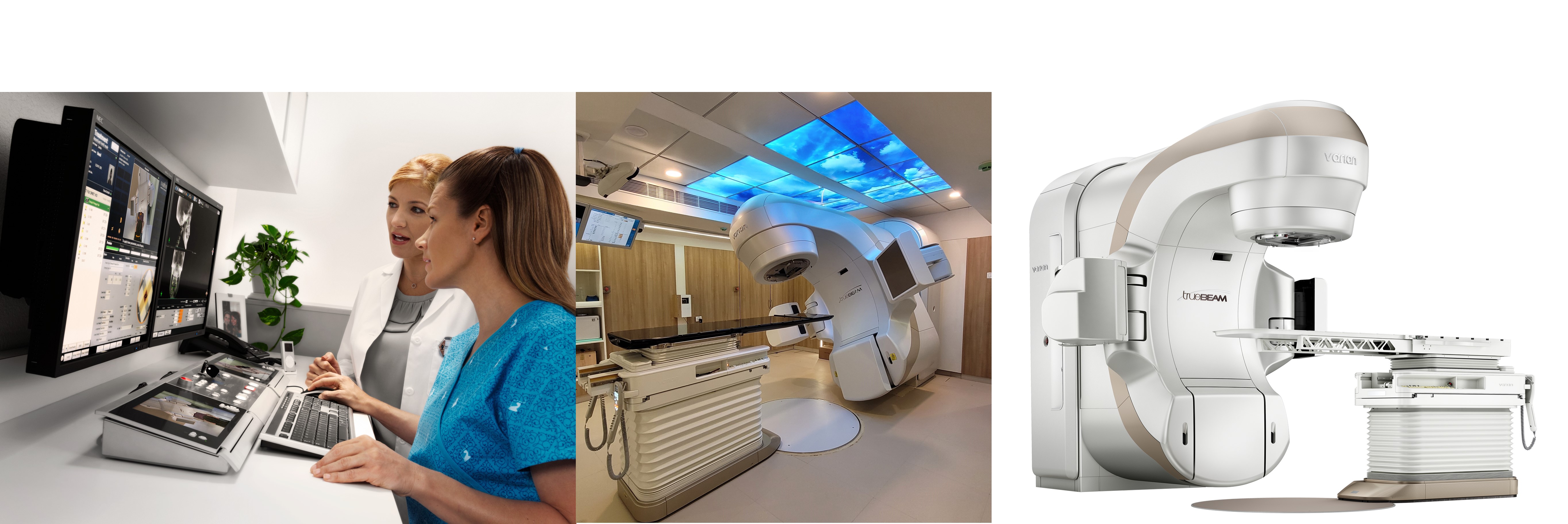Overview
Department of Radiation Oncology, Kasturba Medical College, Mangalore
Established in 1992, the Department of Radiation Oncology at KMC Mangalore was the first cancer department in Mangalore to provide comprehensive cancer care to patients in the region. Since its inception, the department has made remarkable progress, starting with cobalt teletherapy and low-dose-rate brachytherapy and now offering the state-of-the-art linear accelerator and a modern brachytherapy machine, which are considered the global standard in cancer treatment.
The department is dedicated to educating and training professionals in the field of cancer care. It offers a well-structured postgraduate MD program in Radiation Oncology, a Ph.D. program for aspiring researchers, and an undergraduate BSc course in Radiotherapy Technology. Research is a top priority for the department, evident from its extensive publications, conference presentations, collaborations, and clinical trials. Student research and publications are also encouraged.
The department actively engages in community activities, including cancer awareness talks, cancer screening camps, patient support programs and collaborations with NGOs. These initiatives contribute significantly to cancer awareness, early detection, and community support for patients and their families. The department also collaborates with the Indian Council of Medical Research, Government of India, to oversee the Hospital-Based Cancer Registry.
With skilled oncologists leading the way, the department provides comprehensive cancer care through chemotherapy, immunotherapy, and radiation therapy. Multidisciplinary tumour boards are conducted along with the Departments of Medical Oncology, Surgical Oncology, Palliative Care, Radiology, and Pathology to promote a rich clinical, academic, and research environment, involving various hospitals within the institution. This collaborative effort ensures a holistic approach to cancer care. A dedicated team of medical physicists, nurses, technologists, and patient coordinators supports the department in delivering patient care.
With an unwavering commitment to patient care, technological advancements, and collaboration with stakeholders, the department continues to make a significant impact in the fight against cancer.
Faculty
Facilities
Linear Accelerator : Radiation Oncology department at KMC Hospital, Attavar is equipped with state of the art High Dual Energy Linear Accelerator delivering both photon and electron beam treatments using high precision IMRT, Rapid arc using image guidance (IGRT) techniques. The department offers high precision cancer treatment with stereotactic radiosurgery (SRS), stereotactic body radiotherapy (SBRT) and Motion Gated treatment techniques. This unit tailors’ high energy X-rays or electrons to the geometry of tumour, destroying cancer cells while sparing healthy tissue. It has numerous built-in safety precautions to ensure that the dose is delivered as prescribed, and its quality assurance tests are done on a regular basis to confirm its functionality.
High Energy Medical Linear Accelerator (LINAC) - Truebeam
Photon mode treatment (6, 10 & 18MV Photons in FF and 6MV & 10MV FFF photon mode): 3DCRT, IMRT, IGRT, Rapid Arc/VMAT, Gated treatments, SRS & SRT
Electron Mode treatment (five energies)
The department is equipped with various facilities that enable a wide range of treatment options for various types of cancers, tailored to each patient's specific needs, ensuring optimal outcomes in the fight against cancer.
3DCRT (3D Conformal Radiotherapy) utilises advanced imaging techniques to precisely shape radiation beams and deliver treatment from multiple angles, ensuring delivery of targeted radiation therapy to cancer.
IMRT (Intensity-Modulated Radiotherapy) is a sophisticated technique that allows for precise modulation of radiation intensity, enabling the delivery of varying radiation doses to different regions within the treatment field. This precision helps to spare healthy tissues and organs, resulting in enhanced treatment outcomes.
VMAT (Volumetric Modulated Arc Therapy) is an advanced form of radiotherapy that uses continuous rotation of the treatment machine around the patient, delivering radiation beams of varying intensity and shape. VMAT ensures efficient and precise treatment delivery while reducing treatment time and enhancing patient comfort.
IGRT (Image-Guided Radiotherapy) employs real-time imaging technology to precisely locate and track the tumour position during treatment sessions. This technique allows for accurate adjustments to be made in real-time, ensuring the radiation is precisely delivered to the tumour while minimising exposure to surrounding healthy tissues.
SBRT (Stereotactic Body Radiotherapy) is a highly precise form of radiation therapy that delivers high doses of radiation to small, well-defined tumours in a limited number of treatment sessions. SBRT offers exceptional tumour control while minimising side effects to nearby healthy tissues.
SRS (Stereotactic Radiosurgery) is a non-invasive technique that delivers a highly precise and concentrated dose of radiation to small, well-defined brain tumours or other intracranial targets. SRS effectively treats tumours without the need for surgery, offering a safe and efficient treatment option for patients.
Total Skin Electron Therapy (TSET) is a specialised technique that delivers uniform radiation doses to the entire surface of the skin, enabling effective management of skin-related malignancies.
Total Body Irradiation (TBI) is a radiation therapy technique used in preparation for hematopoietic stem cell transplantation, delivering targeted radiation to the entire body to eradicate cancer cells for a successful transplant
4D CT and Respiratory gating synchronises the delivery of radiation beams with the patient's breathing cycle, ensuring accurate targeting of tumours affected by respiratory movements.
Triggered Imaging is a capability of the TrueBeam delivery system that acquires single kV images during treatment delivery. Image acquisition can be triggered by elapsed time, MU delivered, gantry angle, or breathing motion of the patient.
Blood Component Irradiation: Blood component irradiation is done in the department for patients with leukemia making blood transfusions safer for leukemia patients with weakened immune systems.
Extra Corporeal Radiation Therapy: Extracorporeal irradiation radiation therapy is a method used in the management of bone tumours. It consists of en-bloc removal of the tumour-bearing bone segment, removal of the tumour from the bone, irradiation, and re-implantation back in the body.
Brachytherapy: Brachytherapy is a type of radiotherapy that involves placing a sealed radiation source inside or adjacent to the area that has to be treated. The department of radiation oncology is equipped with the state of the art brachytherapy facility using a HDR Cobalt 60 Isotope as the source, which is the first and only one in the region. Brachytherapy is an essential part of treatment for cancer treatment sites e.g., Gynecological (cervical, vaginal, endometrial), Esophageal, Prostate, Head and neck, Breast, Lung, Rectal, Soft tissue, and Skin. It can also be used to treat tumours in other parts of the body.
The Brachytherapy facilities use high dose Co 60 isotope source and routinely perform:
Intracavitary brachytherapy for gynecological malignancies(ICBT)
Interstitial brachytherapy (ISBT) for
Gynecological cancers
Head and neck cancers
Limb sparing procedures in soft tissue sarcoma
Intravaginal Brachytherapy
Intraluminal brachytherapy (ILRT) for carcinoma oesophagus
Surface mould brachytherapy.
Chemotherapy and Immunotherapy: The department encompasses a dedicated daycare and inpatient ward for patients to receive chemotherapy, immunotherapy, targeted therapy and hormone therapy, ensuring integrated care for their specific needs. Chemotherapy and Immunotherapy is administered by a multidisciplinary team of experienced oncologists, nurses, and healthcare professionals who work together to provide the best possible outcomes and improved quality of life for patients.
Other Facilities:
Pain and Palliative Care
Psycho-Oncology Support
Paediatric Radiation Oncology
Cancer Rehabilitation Services
In vivo & In vitro radiation experimental research
Nutritional Support
Mould Room Facility
Siemens Radiotherapy CT scan with 4DCT & Respiratory gating
ARIA – Oncology Information System
ECLIPSE treatment planning System
Dosimetry Equipment
Radiation Protection Services
Hospital-Based Cancer Registry
Patient Support Programs
Department Library
TEACHING AND COURSES OFFERED:
The department apart from teaching postgraduates of Radiation Oncology, is also involved in teaching comprehensive oncology to MBBS undergraduates as per the CBME curriculum, and postgraduates specializing in disciplines of Obstetrics and Gynaecology (OBG), Ear, Nose, and Throat (ENT) and Dentistry.
The Department of Radiation Oncology currently offers the following courses:
MD Radiation Oncology
PhD
BSc Radiotherapy Technology
Click here for Research and Publication of the Department Radiation Oncology

Laboratory
The laboratory is geared with world-class equipments

Libraries
Libraries have excellent resources for reference and study

Hospitals
Teaching in hospitals give students hands-on learning
Research & publications
The areas of research include: Evaluation of histogenesis of various organ systems using fetal tissues. Estimation of subcutaneous fat and fibre distribution and types in the abdominal region and its clinical implications. Effect of DHA and Colin on stress induced behaviour and histological changes in the CNS. • Preventive and protective role of cissus quadrangular is extract on diabetes induced osteopenia and bone loss in osteoporosis- a cellular and molecular evaluation. Cellular and molecular mechanisms involved in curative and prophylactic role of Caesalpinia Bonduc extracts on Liver toxicity. Use of lead as nanoparticle in traditional medicine - multi-organ approach to evaluate the functional, cellular and molecular alterations. Role of traditional medicinal preparations in wound healing - structural, biomechanical, molecular evaluations use normal and diabetic wound models.
Testimonials

We get to do everything by ourselves. The sense of freedom and responsibility here ensures that we learn beyond classrooms.
Anshika Gupta
KMC Manipal

It has been a great experience to be at Manipal University for internship, a good opportunity to meet students from different countries.
Saskia Thomassen
KMC Manipal

Manipal is a place with so much diversity but I feel at home. There is no other place like Manipal.
Merin Varghese
KMC Manipal

I find Manipal a very cute little university town, with all comforts like a good gym and swimming pool. It has an international vibe.
Joëlle Fliers
KMC Manipal

The learning environment here is unique. The infrastructure is designed to facilitate hands-on learning. I love the life here as a student!
Deeksha Sarin
KMC Manipal





